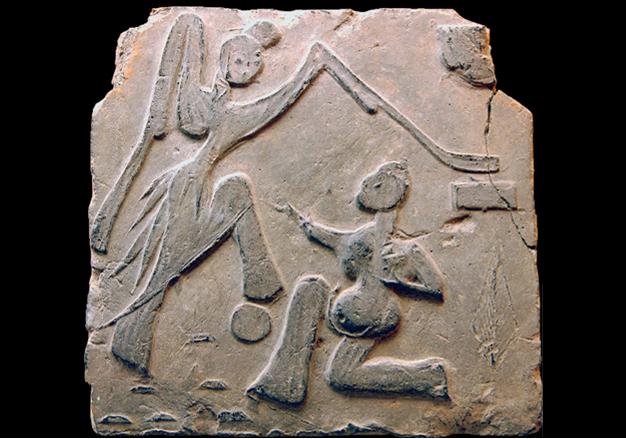
Graduated from the History School of Zhengzhou University with a master's degree, currently serves at the Exhibition Dept. of Henan Museum

Shao Dan: Postgraduate of Designing Art, assistent museologist in the Exhibition Dept. of Henan Museum, engages in exhibition form designing.
Two plate-and-drum dancers are realistically depicted in high relief. The entire scene looks lifelike and is full of vitality. Plate-and-drum dance reached its heyday in the Han Dynasty. Dancers placed a number of plates and drums on the ground upside-down and tapped on them in rhythm. The female dancer on the left of the brick has her hair worn in a bun high on her crown and is clad in a long-sleeve feather gown. She is lifting her arms and swinging her sleeves in an elegant way. Six plates are placed upside-down on the ground. The female dancer has one foot on a drum, as if jumping swiftly and nimbly on the plates and drum, dancing gracefully. On the lower right of the brick kneels a male dancer, one knee on the ground. Bare-breasted, the man has one arm extending forward and is looking up at the female dancer. On the upper right of the brick there are zun and ding vessels. Therefore, the brick is supposed to depict a sing-and-dance performance on a banquet attended by nobles in the Han Dynasty (Figure 1). It illustrates what a plate-and-drum dance of the Han Dynasty looked like, making a supplement to the written records and providing a precious physical evidence for the research on the plate-and-drum dances of the Han Dynasty.
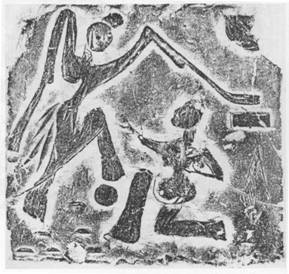
Figure 1 A rubbing from the portrait brick with plate-and-drum dancers
The Han Dynasty enjoyed a “Grand Unification” at home and a great fusion of Chinese and Western cultures, and the art naturally saw a great boom, development and blending. The music-accompanied dances of the Han Dynasty finally got rid of the restrictions of the ancient ones, mushrooming with styles totally different from those in the pre-Qin period. The Han Dynasty saw unprecedented boom and the first peak of the dance art in China, thanks to its varieties of dances performed by skillful dancers in so wide a range.
The music-accompanied dances thrived in the Han Dynasty among commoners and in the court. Large in number, the documents and written histories about the music-accompanied dances of the Han Dynasty were too simple and abstract, so that it is hard to get more details nowadays. The stone reliefs and portrait bricks discovered in the Han tombs then provided us with precious images of the social life, economy and art of the Han Dynasty. As Jian Bozan put it, “Collecting those stone-carvings in a systematic way, we may have an illustrated history of the Han Dynasty.” A large number of the stone reliefs and portrait bricks discovered so far depict various dances of the Han Dynasty, revealing the scene back then. With these lifelike images, we draw the following conclusions about the dance art of the Han Dynasty:
First of all, skills were integrated with dancing, powerful yet elegant-looking. A dancer had soft and graceful manner in dancing integrated with nimble and breathtaking acrobatic movements, blending softness and strength. A dance was thus better to the eye, thanks to its richer meanings and a stronger sense of aesthetic beauty.
Secondly, what was popular with commoners was adopted, transformed and elevated. Music-accompanied dances were popular with both commoners and the court in the Han Dynasty. The Han court established a special Music Bureau or Yue Fu institute, to collect folk songs and dances for ceremonial occasions at court. During the reign of Emperor Wu of Han, folk music and dances were officially adopted in the imperial sacrificial ceremonies, marking the successful transformation and transplantation of popular culture into refined tastes. Popular music-accompanied dances, in this way, gained its popularity with the high class and led to the decline of the traditional refined music-accompanied dances.
Thirdly, beauty and ugliness were humorously incorporated in the same scene and left people an impression of vivid funniness. We find in many portraits of dancers of the Han Dynasty the “clown” element incorporated on purpose. It was an aesthetic taste unique to the music-accompanied dances of the Han Dynasty. Particularly in a plate-and-drum dance or long-sleeve dance, the major dancer was usually a female with a soft waistline, her beauty highlighted by a comedian companion. This seriocomic scene vividly demonstrates an open, humorous and light-hearted art style of the Han Dynasty.
Fourthly, dancers of the Han Dynasty tried to express their ideas and thoughts through their dances. They didn’t simply show off their skills in dancing, despite all those difficult movements. Instead, dancers back then aimed to express what was on their mind or in their heart through their performances.
The plate-and-drum dance was quite popular a dance type in the Han Dynasty and widely depicted in the Han painting. It could be further categorized according to the images on the stones reliefs and portrait bricks of the Han Dynasty discovered in different places.
In the first place, plate-and-drum dances may be performed in three ways, in accordance with the number of plates and drums used. Only one case has been found so far that the dance was performed with plates but without drums (Figure 2). In some cases, only drums were used, known as drum-tapping dances (Figure 3). In a third case, plates and drums were used together. It was a type most commonly seen. In addition, plates might be placed upside-down or with mouths facing upwards (Figure 4). The latter was more often seen in the stones reliefs and portrait bricks of the Han Dynasty.

Figure 2 A line drawing of plate-and-drum dance performed without drums
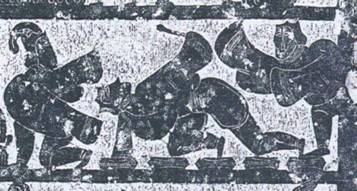
Figure 3 Part of a stone relief of music-accompanied dance unearthed from the Eastern Han tomb in the Songshan Village, Jiaxiang County, Shandong Province: A drumstick-holding drum-tapping dancer
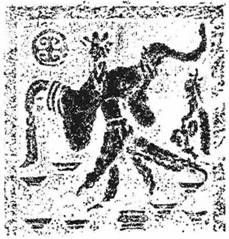
Figure 4 Part of a stone relief of the Han Dynasty unearthed in Licheng, Shandong Province: A plate-and-drum dance with upward-facing plates
Moreover, plate-and-drum dances could be also categorized, according to the number of performers and their genders, into solo dance, group dance and dance duet. Solo dance was the main type. As shown in the unearthed objects, a solo dance was mostly performed by a female dancer (Figure 5). In a case of a male solo dancer, he would look more vigorous and powerful with his masculine postures (Figure 6). A dance duet was distinguishable for the accompanying comedian of the female dancer wearing a long-sleeve gown. The two dancers then formed a sharp contrast between the beauty and the clown, enriching the entire scene.
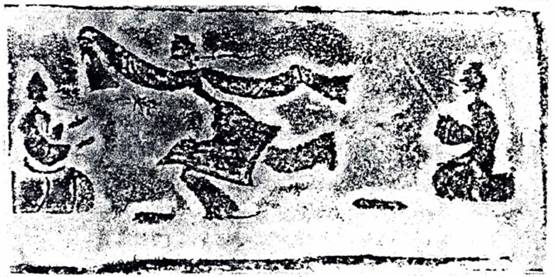
Figure 5 A portrait brick unearthed in Erligang, Zhengzhou, Henan Province:
A female drum-tapping dancer
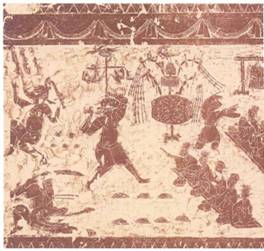
Figure 6 Part of a stone relief depicting music-accompanied dances and acrobatics unearthed from the Eastern Han tomb in the Beizhai Village, Yi’nan, Shandong Province: A male solo dancer performing a plate-and-drum dance
There were also some images of the Han Dynasty depicting quite difficult movements in a plate-and-drum dance. For example, a stone relief depicted a dancer doing a handstand on two drums (Figure 7), his colleagues trying to make it more difficult for him. Handstands were often seen in the stone reliefs or portrait bricks of the Han Dynasty, indicating that the performers had mastered the movement back then. Dancers also practiced somersaults composed of continuous handstands and jumps, known as nixing liandao (Figure 8). This skill required from a dancer a perfect coordination of eyes, hands and strength. He needed to practice smoothly handstands and jumps in a chain on plates and drums. Some written records described a drum-tapping dance in retreat. It was quite difficult actually. In such a dance, the dancer, while moving backwards, had to tap on drums to the drum beats in a perfect order and kept his two feet from tapping on the same drum at the same time (Figure 9).
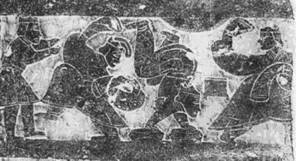
Figure 7 A stone relief unearthed from the Eastern Han tomb at the Ancestral Hall of Family Wu, Jiaxiang County, Shandong Province: A dancer playing a handstand on drums
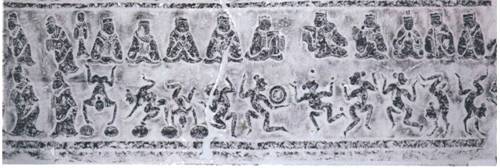
Figure 8 Part of a stone relief depicting music-accompanied dances and acrobatics unearthed from the Eastern Han tomb in the Nanzhang Village, Jining, Shandong Province: Dancers practicing somersaults
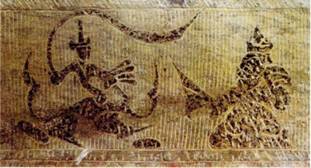
Figure 9 Part of a stone relief depicting a drum-tapping dance unearthed from the Eastern Han tomb in the Shiqiao Town, Nanyang, Henan Province: A drum-tapping dance in retreat
Plate-and-drum dance performances could be quite simple or rather complicated. A simple performance was given by one or more dancers on plates and/or drums. In a complicated one, however, there were also an orchestra and other accompanying dancers. The size of an orchestra varied. The one depicted in a stone relief depicting music-accompanied dances and acrobatics unearthed from the Eastern Han tomb in Yinan has been the largest one found so far (Figure 10). As shown in the stone, 17 musicians were playing 10-plus types of musical instruments of eight different materials. In addition, there were a number of singers.

Figure 10 A stone relief depicting music-accompanied dances and acrobatics unearthed from the Eastern Han tomb in the Beizhai Village, Yinan, Shandong Province
As shown by the images of the Han Dynasty that have survived today, plate-and-drum dancers were clad in similar costumes: a knee-length tunic and a pair of pants, with long scarves or long sleeves. The costumes were designed for the nimble movements made by a dancer on plates and drums. In a performance, a dancer needed to move lightly and nimbly and kept a good balance on small plates and drums. In the meantime, he/she had to tap rhythmic drum beats in various complicated movements. Such a dance must have been a rhythmic one accompanied by melodious music. Masculine and feminine beauty made an admirably harmonious blending in a plate-and-drum dance.
Based upon the analysis of the existing historical documents of the music-accompanied dances of the Han Dynasty, what kind of music would be played to a plate-and-drum dance back then?
Your answer please, if you have any questions or answer, please feel free to send us email, we are waiting for your answers and participation, and your comments, answers and suggestions will be highly appreciated. We will select and publicize the most appropriate answers and comments some time in the future.
Weekly Selection Email: meizhouyipin@chnmus.net
Dance Types in the Han Dynasty
As shown by the discovered stone reliefs and portrait bricks of the Han Dynasty, dances were in various types and styles at that time. As for the function of a dance, a music-accompanied dance in the Han Dynasty could be for performance or self-entertaining and body-building. The former was the major type. Dances for performance were categorized into subtypes according to the instruments used, such as long-sleeve, scarf, plate-and-drum, stemmed-drum, hanging-drum, fan, weaponry and free-standing dances.
A mainstream type, the long-sleeve dance was commonly seen in the stone reliefs and portrait bricks of the Han Dynasty. It originated from the dance of State Chu during the Spring and Autumn Period and the Warring States Period. A dancer played with his/her long sleeves in a performance. The long sleeves looked like dragons flying in clouds and the scene seemed to be filled with romanticism. Long sleeves varied in width. Narrow sleeves were quite commonly depicted in the stone reliefs and portrait bricks of the Han Dynasty (Figure 11), while wide ones were relatively rare, except the images found in the stone reliefs unearthed in Sichuan and Anhui provinces (Figure 12).
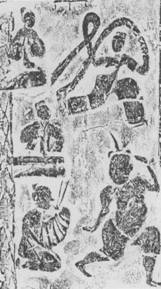
Figure 11 Part of a portrait brick depicting the music-accompanied dance unearthed from the Eastern Han tomb in the Xinye County, Nanyang, Henan Province: A narrow long-sleeve dance

Figure 12 Part of a stone relief depicting Queen Mother of the West, long-sleeve dance, violent fighting and fishing scene unearthed in the Suxian County, Anhui Province: A nine-dancer long-sleeve dance
The scarf dance was an important type performed on a banquet in the Han Dynasty. Dancers danced with long or short scarves in their hands. Having a similar effect to a long-sleeve dance, a scarf dance may be easier to practice, to some extent, as a dancer could command a better control over scarves and give a better performance. A dancer could play with his/her long scarves in quite an eye-catching and breathtaking manner. (Figure 13)
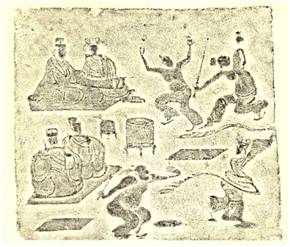
Figure 13 A portrait brick depicting the bell-and-sword acrobatics at a banquet unearthed from the Eastern Han tomb in Dayi, Sichuan Province: A dancer holding long scarves in hands
In a stemmed-drum dance, a tall stemmed drum stood high in the center. The dancers danced around it and beat it to a certain rhythm. The drum body was long and round, supported by a wooden post penetrating through it. The stemmed-drum dance was almost indispensible on a grand occasion, as the major performance accompanied by other music-accompanied dances. (Figures 14 and 15)
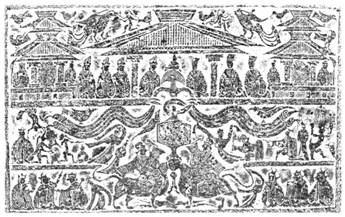
Figure 14 A stone relief depicting music-accompanied dances and acrobatics unearthed from the Eastern Han tomb in the Liangcheng Town, Weishan County, Shandong Province

Figure 15 A stone relief depicting the stemmed-drum dance and acrobatics unearthed from the Eastern Han tomb in the Yingzhuang Town, Nanyang, Henan Province
The Han Dynasty boasted dances in numerous types and forms. We hope that you may have a concise and direct idea about what the dances of the Han Dynasty were like through our simple descriptions of the typical ones.
